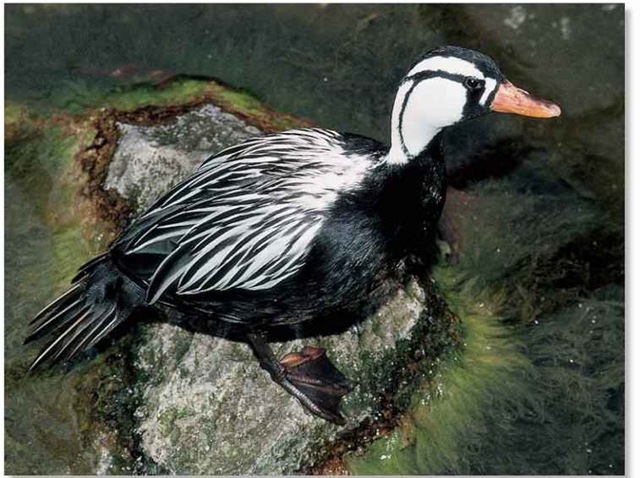ORDER
Anseriformes
FAMILY
Anatidae
GENUS & SPECIES
key features
Unusual among ducks in its preference for fast-flowing mountain streams with many waterfalls Simply built, long-tailed and short-legged; dives into the rapids to find insects on the riverbed one of the most attractive ducks, the male has a striking black-and-white head and orange bill
where in the world?
Resident in three separate areas of the Andes of western South America:Venezuela to southern Colombia; Ecuador to Peru; and south through Bolivia and chile to Argentina

LFECYCLE
The torrent duck lives up to its name as a fearless aquatic forager of the swirling eddies, tumbling cascades and rushing rapids that spill from the high Andes.
HABITAT
The torrent duck exploits a difficult aquatic environment. Unlike most ducks, which seek calm waters, the torrent duck thrives on shallow, white-water rivers and streams. High-speed currents quickly wash nutrients downstream, and the waters are often heavily cobbled with rocks and boulders. As a result, food is scarce and difficult to reach. By adapting to exploit this niche, however, this duck has few competitors for food resources.
The torrent duck favors rivers and streams with areas of calmer water where it can take a rest between its demanding bouts of feeding.
There are six races of torrent duck. Females look the same, but males vary. For example, the Chilean race has a black chest and chestnut belly, while the Bolivian and Colombian races have no black.
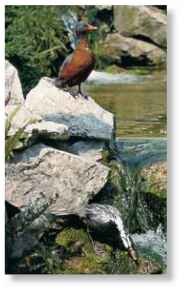
A Slow with the flow A pair rests by a calm stretch of water.
BREEDING
WHITE-WATER GRAFTING

Hard at rest…
Swimming against rapids while feeding is hard work, so the duck takes regular rests on
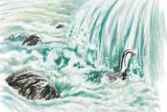
Heading for a fall…
Back in the water, the torrent duck heads for a curtain of falling water. These places often hide many caddis-fly larvae and snails.
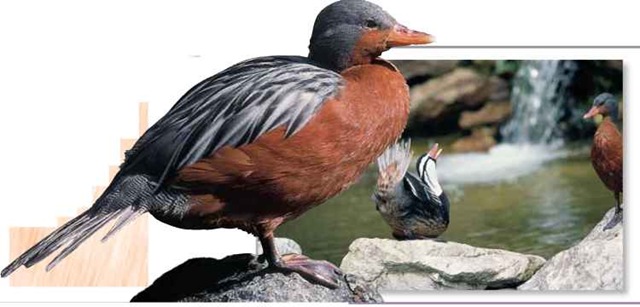
FOOD & FEEDING
The diet of the torrent duck consists mainly of caddis-fly larvae, other aquatic insects, snails and a few fish. In the challenging mountain rapids, the duck uses various techniques to find food.
Foraging mainly by day, the torrent duck dives into rushing rivers to search for food among the rocks and sieve through the bottom debris. In shallow water, it stands and dips its head below the surface to snap up invertebrates. In calmer waters, it up-ends, reaching down with its long neck to explore the streambed. It also feeds at the foot of a waterfall, with water crashing over its body, or climbs onto slippery ledges behind the cascade to feed among plants growing on the rocks.
Fast food
These ducks scour rocks that hide aquatic larvae.
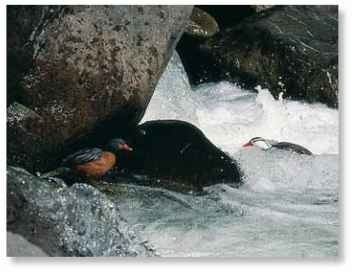

Taking a dive…
Ignoring the battering water and the racing current, the torrent duck dives under the waterfall and swims down to the streambed.
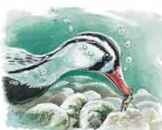
Hard case
It probes urgently among the stones. Finding a caddis-fly larva, it crushes its protective casing and quickly swallows it.
The torrent duck is territorial throughout the year, which is uncomon in ducks. In keeping with such behavior, the male and female often pair for life, defending a stretch of river
At the beginning of breeding season, both the male and female construct the nest with dry grass and line it with down and feathers. Nest sites vary from a cavity among rocks, on a cliff ledge or in thick streamside vegetation. Even the abandoned nest burrow of a ringed kingfisher may be used. The female incubates the clutch of eggs.After about six weeks, the chicks hatch; they are boldly striped with black-and-white spots. They leave the nest within hours and have the swimming skills to feed in calm waters, though their buoyant down prevents them from diving. Juveniles are unlikely to find their own territory until they’re a year old.
Showtime The male displays to a potential mate.
BEHAVIOR
The torrent duck is normally sedentary, found in pairs or small groups scattered along suitable stretches of river: Parties of males may also gather to display for females during breeding season.
At the higher altitudes in its range, the torrent duck may be driven from its territory by severe winter weather and moves to warmer areas at lower levels farther downstream. If it intrudes on another duck’s territory, the newcomer may have to fight with the owner to gain a feeding site. Similarly, young birds may have to wander within their range, avoiding aggressive residents, before finding an unoccupied territory of their own.
High-minded The torrent duck often swims with its body held very high — appearing to walk on the water.

CONSERVATION
The torrent duck is not considered threatened, but is declining in many places, especially in the northern parts of its range. Its disappearance owes much to deforestation, which causes siltation — the lack of trees means that soil is washed away more easily.The increased runoff also causes flash floods, which destroy nesting sites.
PROFILE
Torrent Duck
Powerful webbed feet, a streamlined body and stiff tail feathers equip the torrent duck to live in fast-flowing waters.
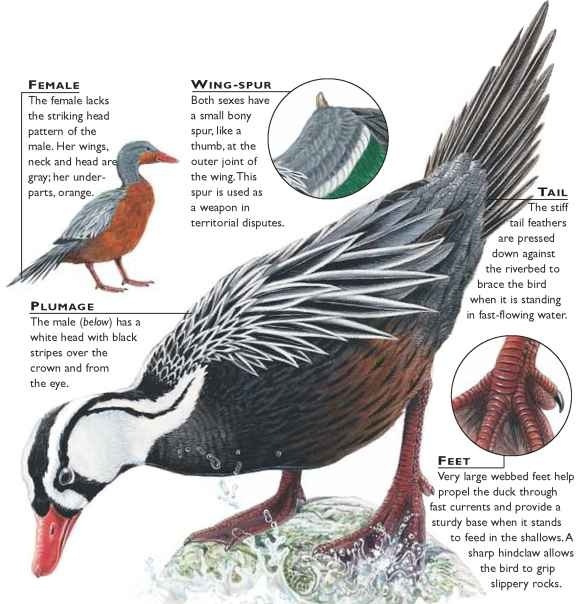
CREATURE COMPARISONS
The blue duck (Hymenolaimus malacorhynchus), which takes its name from its uniformly blue-gray
Dring, is found only in New Zealand. Like the torrent duck, it is an inhabitant of fast-flowing streams. Standing about 22″ high, the blue duck is taller than the torrent duck but stockier than its relative.The blue duck is mainly sedentary, living along the same stretch of river for most of its Jult life. Increasingly rare, the blue duck feeds in a similar way to the torrent duck, probing among rocks, diving and up-ending in shallows fo aquatic invertebrates, including larvae.
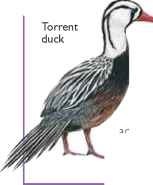
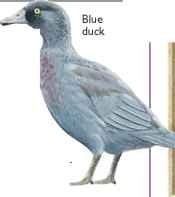
| VITAL | |
| STATISTICS | |
| Weight | 11-15 oz. |
| Length | 17-18.5″ |
| Wingspan | 22″ |
| Sexual Maturity | 1 year |
| Breeding Season | Variable, usually between Nov. and June |
| Number of Eggs | 3-4 |
| Incubation Period | 43-44 days |
| Fledging Period | Unknown |
| Breeding Interval | Probably 1 year |
| Typical Diet | Aquatic insects and larvae, mollusks and small fish |
| Lifespan | Unknown |
RELATED SPECIES
• The torrent duck is the only species in the genus Merganetta. This genus is in the family Anatidae, which contains ducks, geese and swans. I The 147 members of this diverse family are found I worldwide, except on I Antarctica, and range in size from the massive whooper swan, Cygnus cygnus, which weighs over 26 lbs., to the African Pvgmv goose, Nettapus auritus, weighing just 9-10 oz. .
